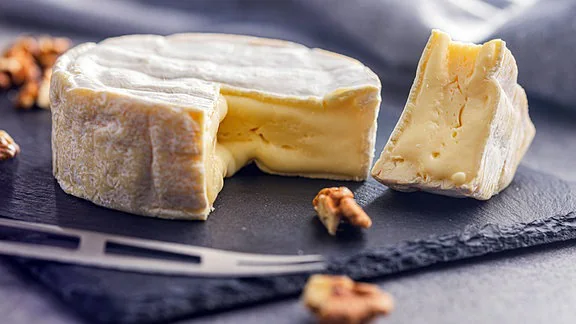Camembert, with its fluffy white rind and creamy center, stands as one of France’s most iconic cheeses. However, recent warnings from researchers suggest that the future of this beloved delicacy may be in jeopardy due to concerns surrounding the fungal strain crucial for its production.
French researchers have sounded the alarm regarding the potential demise of Camembert with its distinctive white, fluffy rind. According to a report in “Le Journal” from the French National Center for Scientific Research (CNRS), the soft cheese currently relies on a single fungal strain known as Penicillium camemberti. This strain, crucial for imparting Camembert‘s unique flavor and texture, is not sexually reproduced, leading to a lack of genetic diversity. Over time, this has resulted in the strain losing its ability to produce the spores necessary for reproduction. The report highlights the growing difficulty for producers in obtaining an adequate supply of this fungal strain.
Biologist Tatiana Giraud from the Université Paris-Saclay, however, does not see an immediate threat. “The Camembert industry will not be threatened in the next five to ten years,” she told “Le Parisien.” “But we want to raise awareness of the dangers of excessive species uniformity,” she is quoted by “Libération.”
In fact, according to the CNRS magazine, until the mid-20th century, Camembert‘s rind was sometimes tinged with shades of orange, gray, or green. However, companies gradually shifted towards exclusively using the white fungal strain, which has been in use for Camembert production since as early as 1902. The issue of limited microbial diversity also extends to other cheese varieties, such as Roquefort, as noted by CNRS. However, Camembert appears to be particularly vulnerable.
There is potential to ferment Camembert using alternative fungal strains. However, consumers would need to adjust to potential changes in color, texture, or flavor of the cheese. This raises questions about whether traditionalists would accept such alterations or whether they would be willing to preserve the essence of Camembert, even at the cost of its originality.
The warnings from researchers serve as a wake-up call to the cheese industry and consumers alike. While the immediate threat may not be dire, the long-term implications of relying on a single fungal strain for Camembert production are concerning. Preserving biodiversity in cheese-making processes is not only crucial for maintaining culinary traditions but also for safeguarding the future of beloved delicacies like Camembert. As discussions around sustainability and diversity continue to gain traction, it is imperative that efforts are made to explore alternative fermentation methods while ensuring the preservation of the essence of these iconic cheeses. After all, the richness of culinary heritage lies in its diversity, and the future of Camembert depends on embracing this diversity rather than succumbing to uniformity.





